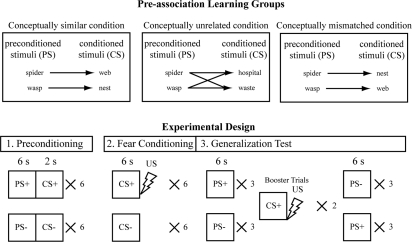Figure 1.
Schematic of experimental design. The preconditioned stimuli (PS)—pictures of a spider and wasp—were held constant across the three experimental groups. In the first phase of the experiment (sensory preconditioning), subjects learned the association between the PS and a conditioned stimulus (CS) that was either conceptually similar, unrelated, or conceptually mismatched. Subjects were instructed to predict which image would follow the offset of the PS as quickly and accurately as possible by pressing one of two buttons (counterbalanced between subjects). The task was intended to be simple to promote a strong association between the PS and its corresponding CS in all groups; consequently, all subjects correctly predicted the associated CS by the end of the preconditioning phase. Subjects were informed that no shocks would occur during this phase of the experiment, but were not informed of the PS–CS contingencies. In the next phase of the experiment (fear conditioning), one CS (CS+) was reinforced by an aversive electrical shock unconditioned stimulus (US) on 100% of trials, while the other CS (CS−) was never paired with the US. Subjects were informed at the start of fear conditioning that the task was to identify the image on the screen as quickly and accurately as possible by pressing one of two buttons (counterbalanced between subjects). Subjects were informed that the US would occur, but were not informed of the CS–US contingencies. For the conceptually similar and mismatched conditions, the CS+ and CS− stimuli were counterbalanced between subjects as either the spider web or the wasp nest. This ensured that the PS+ and PS− were also counterbalanced between subjects as either the spider or the wasp. For the conceptually unrelated condition, the spider and wasp equally served as the PS+ (and PS−) in this condition as well. The final phase (generalization testing) immediately followed fear conditioning without a break, and subjects continued to identify the images on the screen by pressing one of two counterbalanced buttons as quickly and accurately as possible. After three PS+ and three PS− trials, there were two CS+ trials paired with the shock. These “booster” trials were included to reduce habituation (e.g., Smith et al. 2006; Lim and Pessoa 2008), and data from these trials were not included in any analyses. Three additional PS+ and PS− trials followed the “booster” trials.

